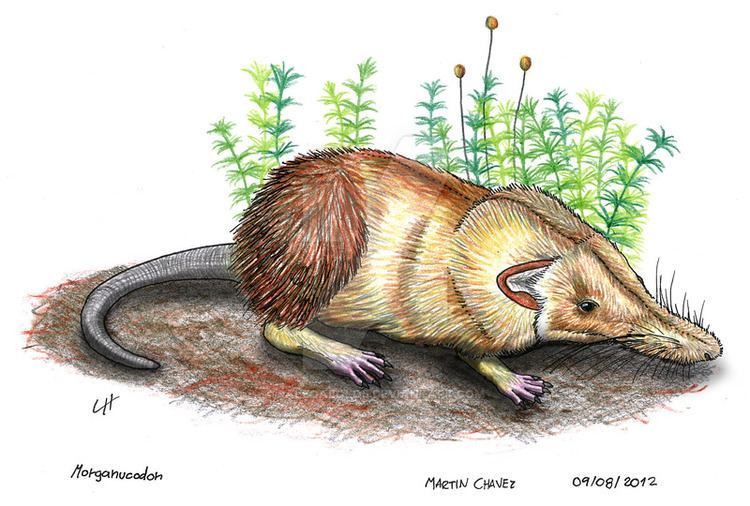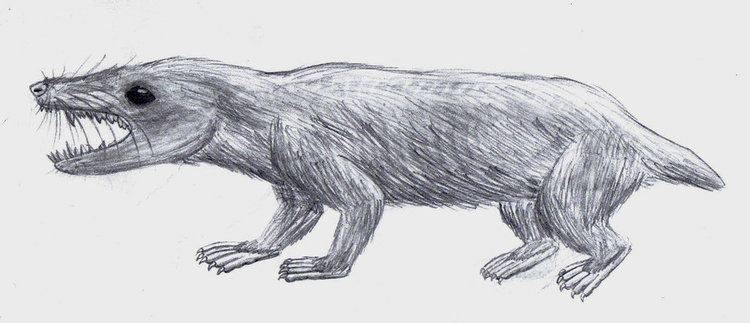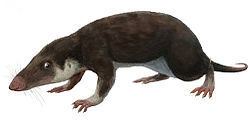Family †Morganucodontidae Rank Genus | Phylum Chordata Order Therapsid | |
 | ||
Similar | ||
Lecture 68 morganucodon the first true mammal
Morganucodon ("Glamorgan tooth") is an early mammaliaform genus that lived during the late Triassic period. It first appeared about 205 million years ago. Unlike many other early mammals, Morganucodon is well represented by abundant and well preserved, though in the vast majority of cases disarticulated, material. Most of this comes from Glamorgan in Wales (Morganucodon watsoni), but fossils have also been found in Yunnan Province in China (Morganucodon oehleri) and various parts of Europe and North America. Some at least closely related animals (Megazostrodon) are known from exquisite fossils from South Africa.
Contents
- Lecture 68 morganucodon the first true mammal
- Morganucodon evolutionism versus creationism
- Biology
- Classification
- References

The name comes from a Latinization of Morganuc, "South Glamorgan in the Domesday Book", the county where it was discovered by Walter Georg Kühne, so it means "Glamorgan tooth". It has acquired the nickname Morgie in the Smithsonian National Museum of Natural History.

Morganucodon evolutionism versus creationism
Biology

Morganucodon was a small, plantigrade animal. The tail was moderately long. According to Kemp (2005), "the skull was 2-3 cm in length and a presacral body length of about 10 cm [4 inches]. In general appearance, it would have looked like a shrew or mouse". There is evidence that it had specialized glands used for grooming, which may indicate that, like present day mammals, it had fur.

Like present day mammals of similar size and presumed habit, Morganucodon was likely nocturnal and spent the day in a burrow. There is no direct fossil evidence, but several lines of evidence point to a nocturnal bottleneck in the evolution of the mammal class, and almost all modern mammals of similar size to Morganucodon are still nocturnal. Likewise, burrowing was widespread both in the cynodonts and in primitive mammals. The logics of phylogenetic bracketing would make Morgunacodon nocturnal and burrowing too. Plant material from the conifer Hirmeriella was also found in the fissure fills, indicating Morganucudon lived in, or near, a forested area.

The diet appears to have been insects and other small animals, again much like a modern shrew. Like most modern mammal insectivores, it grew fairly quickly to adult size. Unlike its therapsid ancestors, Morganucodon likely lived a rather short life, similar to those of most small mammals today. Its eggs were probably small and leathery, a condition still found in monotremes.
The teeth grew in mammalian fashion, with deciduous teeth being replaced by permanent teeth that were retained throughout the rest of the animal's life. The combination of rapid growth in juveniles and a toothless stage at infancy strongly suggests that Morganucodon raised its young by lactation; indeed, it may have been among the very first animals to do so. The molars in the adult had a series of raised humps and edges that fit into each other, allowing for efficient chewing. However, unlike the situation in most later mammals, the upper and lower molars did not occlude properly when they first met; as they wore against each other, however, their shapes were modified by wear to produce a precise fit.
Classification
Morganucodon is the type genus for the order Morganucodonta, a group of generally similar mammals or pre-mammals from Late Triassic to Middle Jurassic time of the close relatives. All were small and mainly insectivores. Of the small bodied relatives, Morganucodon is the best preserved and best understood find.
There is currently controversy about whether or not to classify Morganucodon as a mammal or as a non-mammalian mammaliaform. Some researchers limit the term "mammal" to the crown group mammals, which would not include Morganucodon and its relatives. Others, however, define "mammals", as a group, by the possession of a special, secondarily evolved jaw joint between the dentary and the squamosal bones, which has replaced the primitive one between the articular and quadrate bones in all modern mammalian groups. Under this definition, Morganucodon would be a mammal. Nevertheless, its lower jaw retains some of the bones found in its non-mammalian ancestors in a very reduced form rather than being composed solely of the dentary. Furthermore, the primitive reptile-like jaw joint between the articular and quadrate bones, which in modern mammals has moved into the middle ear and become part of the ear ossicles as malleus and incus, is still to be found in Morganucodon. Morganucodon also suckled (it may have been the earliest animal to do so), had only two sets of teeth and grew rapidly to adult size and stopped growing thereafter, all typical mammalian traits.
